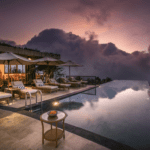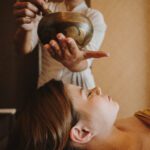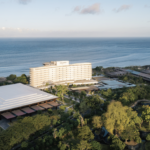Melbourne is the capital and most populous city in the state of Victoria, and the second most populous city in Australia. Located on the large natural bay of Port Phillip, Melbourne is often referred to as Australia’s cultural capital since its the home of international centre for performing and visual arts. A ride along Melbourne surely wouldn’t be as dull as you thought! Here we enlist 10 places to go to in Melbourne.
1. The Great Ocean Road
The Great Ocean Road is an Australian National Heritage listed 243 kilometres stretch of road along the south-eastern coast of Australia between the Victorian cities of Torquay and Allansford. The road travels via Anglesea, Lorne, Apollo Bay, and Port Campbell, the latter being notable for its natural limestone and sandstone rock formations including Loch Ard Gorge, The Grotto, London Arch (formerly London Bridge) and The Twelve Apostles. At the stretch of the Great Ocean Road nearer to Geelong, the road meanders along the coast, with tall, almost-vertical cliffs on the other side of it. Road signs put up along the road warn motorists of possible rockfalls, which have occurred before. Although warnings of its danger, the road was deemed by the Tourist Development Authority to be one of the world’s great scenic roads in 1962. It also had sections widened between the Lorne Hotel and the Pacific Hotel to improve traffic, while aiming to preserve its character.

2. Royal Botanic Garden
The Royal Botanic Gardens Melbourne is located near the centre of Melbourne, on the south bank of the Yarra River. There are 38 hectares of landscaped gardens consisting of a mix of native and exotic vegetation including over 10,000 individual species. Living collections at the Botanic Gardens include Australian Forest Walk, California Garden, Cacti and Succulents, Camellia Collection, Cycad Collection, Eucalypts, Fern Gully, Grey Garden, Herb Garden, Long Island, New Caledonia Collection, New Zealand Collection, Oak Lawn, Perennial Border, Roses, Southern China Collection, Tropical Display-Glasshouse, Viburnum Collection and Water Conservation Garden. These plant groups have been chosen for their value, rarity, diversity and interest. With its massive number of plant and flower, you can relax and take your time in this botanical paradise.
3. Shrine of Remembrance
The Shrine of Remembrance, located in Kings Domain on St Kilda Road, Melbourne, Australia was built as a memorial to the men and women of Victoria who served in World War I and is now a memorial to all Australians who have served in war. It is a site of annual observances of ANZAC Day (25 April) and Remembrance Day (11 November) and is one of the largest war memorials in Australia. On Remembrance Day, Victorian leaders and community members gather to commemorate “the sacrifices made by Australians in all wars and conflicts”. A minutes silence is observed at 11 a.m. as the Ray of Light illuminates the word LOVE on the Stone of Remembrance.
Throughout the rest of the year, ceremonies and wreath laying services are held by Victorian unit associations and battalions in the Sanctuary, around memorials in the Shrine Reserve and near remembrance trees specific to various associations.

4. National Gallery of Victoria
The National Gallery of Victoria, popularly known as the NGV, is an art museum in Melbourne. Founded in 1861, it is the oldest public art museum in Australia. The NGV operates across two sites: NGV International, located on St Kilda Road in the heart of the Melbourne Arts Precinct of Southbank, and The Ian Potter Centre: NGV Australia, located nearby at Federation Square. Numerous collections of paintings and artworks has been showned in here, both international and domestic artworks. The Australian’s best painting of Charles Blackman and Frederick McCubbin are also hanging along with famous maestro, such as Bernini, Monet and Picasso.
5. State Library of Victoria
The State Library of Victoria is the central library of the state of Victoria, located in Melbourne. The library holds over 2 million books and 16,000 serials, including the diaries of the city’s founders, John Batman and John Pascoe Fawkner, and the folios of Captain James Cook, R.N. It also houses the original armour of Ned Kelly, Australian’s most famous vigilante. What makes its unique than any other world library is the numerous reading rooms with each distinctive theme. There’s total of 7 reading rooms, most famous of them all is The Dome which opened in 1913 and was designed by Norman G. Peebles. Its octagonal space was designed to hold over a million books and up to 600 readers. It is 34.75 m in both diameter and height, and its oculus is nearly 5 m wide. The dome was the largest of its type in the world on completion.

6. Block Arcade
Block Arcade is a heritage shopping arcade in the central business district of Melbourne, Victoria. Melbourne’s Golden Mile heritage walk runs through the arcade. The arcade which was erected between 1891 and 1893 was designed by architect David C. Askew whose brief was to produce something similar to the Galleria Vittorio Emanuele in Milan. The result was one of Melbourne’s most richly decorated interior spaces, replete with mosaic tiled flooring, glass canopy, wrought iron and carved stone finishings. The exterior façade of the six storey office has near identical facades on Collins and Elizabeth Streets and is one of Australia’s best surviving examples of the Victorian Mannerist style. Some say, it’s “the touch of Europe” in Australia.
7. St. Patrick Cathedral
St Patrick’s Cathedral is the cathedral church of the Roman Catholic Archdiocese of Melbourne in Victoria, Australia. The alluring cathedral is famous for its construction, built on a traditional east-west axis, with the altar at the eastern end, symbolising belief in the resurrection of Christ. The plan is in the style of a Latin cross, consisting of a nave with side aisles, transepts with side aisles, a sanctuary with seven chapels, and sacristies. Although its 103.6 metres length is marginally shorter than that of St Mary’s Cathedral, Sydney, St Patrick’s has the distinction of being both the tallest and, overall, the largest church building in Australia.
8. Australian Centre for the Moving Image (ACMI)
For the Movie-Goers, this might be of a delight for you to see. The Australian Centre for the Moving Image (ACMI) is dedicated to the moving image in all forms. It is located in Federation Square, in Melbourne, across four levels of the Alfred Deakin Building. ACMI is a state-of-the-art facility purpose-built for the preservation, exhibition and promotion of Victorian, Australian and International screen content. You can find any Australian movie that you want watch here and also you’re welcome in an open discussion!
9. Old Melbourne Gaol
For those who would want to taste some thrill while in Melbourne, here’s a place to go! The Old Melbourne Gaol is a museum and former prison located in Russell Street, Melbourne. It consists of a bluestone building and courtyard, and is located next to the old City Police Watch House and City Courts buildings. The three-storey museum displays information and memorabilia of the prisoners and staff, including death masks of the executed criminals. At one time the museum displayed Ned Kelly’s skull, before it was stolen in 1978; as well as the pencil used by wrongly convicted Colin Campbell Ross to protest his innocence in writing, before being executed. Paranormal enthusiasts claim the museum is haunted, with claims of ghostly apparitions and unexplained voices near cells. Fancy for a little night tour?
10. Degraves Street
Degraves Street is a street in Melbourne, Victoria. It is named after Charles and William Degraves, pioneer merchants who settled in Melbourne from Hobart, Tasmania in 1849. William Degraves (1821–1883) was also a large-scale grazier and a member of Victoria’s Legislative Council between 1860 and 1874. It is a short, narrow laneway, running north from Flinders Street to Flinders Lane in the central business district of Melbourne. The cobbled bluestone alley forms a busy alternative thoroughfare for commuters disembarking from Flinders Street Station toward the shopping areas of The Block on Collins Street and Bourke Street Mall, loosely connecting with Centre Place, a similar lane just across Flinders Lane. You can find any kind of bars, cafes, and restaurants and many of the taller old buildings have been converted into loft style apartments in the 1990s, making a tour in Degraves street livelier than ever.













